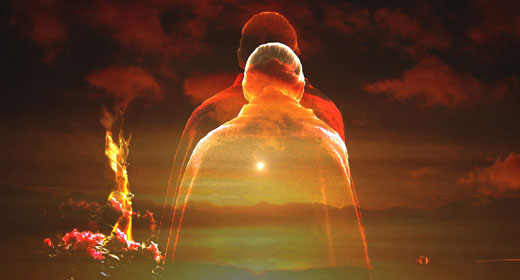By Deepak Chopra, MD, FACP, and Menas Kafatos, Ph.D: The question at hand is whether there is such a thing as higher consciousness?

We are using the term “cosmic consciousness” to denote a state of awareness that knows itself completely, a state of inner silence that is in direct contact with existence. Such a state would be free, without suffering or limitation. If there is such a state, then human evolution has a goal to aim for one that is natural and credible rather than supernatural and faith-based.
As scientific evidence, we began with the quantum vacuum, which is the source of everything that’s deemed “material,” from atoms to galaxies. In everyday usage a vacuum implies total emptiness, but the quantum vacuum is the origin and the end place of our universe, and possibly countless others. In fact, standard quantum field theory gives us an estimate of the mass-energy density of the quantum vacuum: a cubic centimeter of empty space (about the size of the tip of your finger) contains about 10 32 more mass energy-density than all visible matter in the universe! (That’s 1 followed by 32 zeroes, which more energy than all the trillion or so of all luminous galaxies in the observable universe.)
At the source, “quantum foam” is constantly bubbling up to produce everything in creation, here and now. Which means that the quantum revolution that began more than a century ago has effectively overthrown the common-sense notion of matter as something solid, tangible, and reliable. By implication, everything we associate with matter – the sight, sound, touch, taste, and smell of “material” things – has also been overthrown. If that seems radical, quantum theory goes further and dispatches time and space as constant, reliable aspects of reality. They, too, emerge from the “nothingness” of the quantum vacuum.
Why should this matter in everyday life? Because mystics have pointed to a reality that transcends this world, and so does modern physics. It is tantalizing that two worldviews are compatible, both contending that the source of time, space, matter, and energy doesn’t contain time, space, matter, and energy. It lies beyond them, in an inconceivable somewhere that has no location; it’s not a “place” in any common-sense use of the word. Let’s see how deep this agreement goes.
Not only is the quantum vacuum the source and resting place of countless particles (and through them perhaps countless universes). It contains all potentialities of existence, everything we can, and cannot, imagine. The world’s spiritual traditions say the same of God, the Absolute, or what we prefer to call cosmic consciousness. The terminology isn’t important, only the concept of mind preceding matter. Your mind is filled with invisible potential. It contains every word you know and every possible sentence that you might choose to put in words. Even though you speak or think only one word at a time, the number of potential sentences you can make is essentially infinite.
In the quantum model, the space-time continuum contains by far the tiniest of possible energies, since at its foundation resides the quantum foam, where space and time don’t even make sense. The quantum foam contains at least six other dimensions predicted by superstring theory. These emerge but never fully develop into macroscopic scales, as do regular three-dimensional space and one-dimensional time.
Knowing just these scientific facts, it’s clear that as the material world dissolves before our eyes, a more reliable reality must take its place. The new reality isn’t accessible through reductionism, which lies at the core of science as it is now practiced. Reductionism is a bottom-up approach, building the universe from the smallest components of matter and energy. But when the smallest components vanish into the quantum vacuum, and when it’s shown that all the visible matter in the known universe is only 4% of the total (the remaining 96% being formed by “dark” matter and energy that has never been seen or measured), holding out for a bottom-up approach seems doomed. Even dark matter and energy are still much, much less than the zero-point energy of the quantum foam.
The alternative is a top-down approach, which means taking the whole as fundamental before breaking it down into parts. Using a top-down approach is something we do every day. In a crowded department store you don’t search for your six-year-old by breaking down faces into component parts, comparing them, rejecting the ones that statistically are improbable, and then building up your child’s face from the most basic components. You simply recognize your child. In the same top-down way we recognize reality through large-scale intuitive pictures in our heads. Sunlight wasn’t broken down into the colors of the spectrum until Newton, but humans move through a world where “color” is a given. So when John Wheeler says (as we noted in the first post) that all of physics needs to be based on the quantum vacuum, the evidence is mounting that he’s right.
The five senses cannot perceive the quantum world, and yet perception depends upon it. The quantum world is hidden from us the way the operation of the brain is hidden. If you think the word “elephant” and see an image of the animal in your mind’s eye, you aren’t aware of the millions of neurons firing in your brain in order to produce them. Yet those firings – not to mention the invisible cellular operations that keep every part of your body alive – are the foundation of the brain’s abilities.
Just as the image of an elephant is the visible end point of veiled processes, the material world is founded on a veiled reality. Moreover, to produce a single mental image, the whole brain must participate. Specific areas, mainly the visual cortex, produce mental pictures, but they are coordinated with everything else the brain does, such as sustaining the cerebral cortex, which recognizes what an image is, and maintaining a healthy body. This points to two aspects that profoundly link the brain and the cosmos, veiled non-locality and cosmic censorship.
Veiled non-locality describes how the universe – and the human brain – disguises its wholeness in order to produce specific (i.e., local) events. Cosmic censorship, on the other hand, describes the inability of distant observers to directly observe the center of a black hole, or “naked singularity.” The center of the black hole is presumed to be the same as the quantum vacuum. This filtering process allows for specific observations and thoughts in a classical world of everyday experience, while keeping quantum and general relativistic processes out of sight.
As complex as this sounds, the point for everyday life is simple. You are an expression of wholeness, fulfilling the Vedic teaching, Aham Brahmasmi, “I am the universe.” This isn’t mysticism. Your ability to be conscious of anything – the words on this page, the room you are sitting in – depends quite literally on being conscious of the whole universe, even though you don’t know you are. The brain is a reduction to human scale of the quantum vacuum that holds together every event emerging in space-time, and your perceptions are the final filtering of cosmic censorship and veiled non-locality.
Cosmic consciousness tells us that there is one thing – consciousness itself – that underlies the appearance of separate creatures with separate minds. Seeing yourself as separate is a mistake. We don’t make this mistake when someone shows us a diamond. Although the jewel looks separate, we know that one element, carbon, is common to all diamonds, that atoms are common to all the elements in the periodic table, and that quarks and other subatomic particles are common to all atoms. In the same way, even though one person is climbing Mt. Everest and another is asleep in bed in Rangoon, all experiences have mind in common, and mind rests upon a field of consciousness that permeates the universe. This realization delivers the much hoped-for connection between the quantum world and the everyday material world.
Where reductionism, the bottom-up approach, founders on its built-in limitation, a top-down approach flourishes. We’ve suggested how by sketching in some of the scientific implications. In the next post we’ll show how cosmic consciousness can benefit – and perhaps revolutionize – the life of the individual. Without it, the limitations of everyday thought and perception cannot be overcome and, we will argue, society itself might be at risk.
(To be cont.)
Deepak Chopra, MD is the author of more than 75 books with twenty-two New York Times bestsellers including Super Brain, co-authored with Rudolph Tanzi, Ph.D. Join the weightlessproject.org to eradicate obesity and malnutrition. For more interesting articles visit The Universe Within
Menas C. Kafatos is the Fletcher Jones Endowed Professor of Computational Physics at Chapman University. He is a quantum physicist, cosmologist, climate change researcher and works extensively on consciousness and the above fields. His doctoral thesis advisor was noted M.I.T. professor Philip Morrison who studied under J. Robert Oppenheimer. Kafatos’ studies involved quantum physicists Hans Bethe, Victor Weisskopf and cosmologist Thomas Gold. He is co-author with Deepak Chopra of the forthcoming book, Who Made God and Other Cosmic Riddles. (Harmony)









































